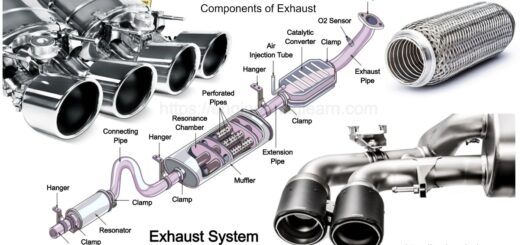Airbag (Car) – Definition, Types, Uses, Components, Working & Advantages [Complete Explained]
![Airbag (Car) - Definition, Types, Uses, Components, Working & Advantages [Complete Explained]](https://engineeringlearn.com/wp-content/uploads/2022/09/Airbags-1024x539.jpg)
Introduction
Airbag (Car) – Definition, Types, Uses, Components, Working & Advantages [Complete Explained]: – Air Bags are pillow-like safety devices, which are found in cars only. These are activated when a vehicle senses a collision. Seat belts are also used for our safety, but these belts work if the driver or passenger buckles up. On the other hand, airbags are designed to activate automatically at the precise moment they are needed.
All new vehicles in many countries include front airbags for the driver and passengers, but many automakers go beyond that minimum requirement.
If you are also searching for the Airbags and more information about it, then you are reading the right article, because we are going to tell you about these things only. To read more about it, read our article till the end. First of all, we will tell you what are airbags, and why these are so important in every car.
What is an Airbag?
An airbag is a pillow-style safety device, which inflates during the events of a frontal crash of an automobile. The purpose of employing the airbag is to provide a cushion for the occupants’ bodies. Hence, it prevents their direct collision with the inner objects like the steering wheel or dashboard. Hence, it is one of the most important safety features of a modern-day car. These days, all the cars are coming with the facility of airbags.
Why these are Useful?
Airbags reduce the chance of your upper body or head, which can strike the vehicle’s interior during a crash. To prevent an airbag-related injury, make sure you are properly seated and remember air bags are designed to work with seat belts, not replace them.
How Do Air Bags Work?
Airbags have multiple sensors and work on these sensors only. Its sensors are placed in such positions which are likely to be compromised in the event of an accident, wheel-speed sensors, data from accelerometers, and other sources feed the airbag control unit. If any specific condition is detected, then the control unit immediately activates the airbags.
When a control unit detects any of the predetermined conditions, it sends a signal to activate one or more initiator devices. The chemical propellants are ignited after that, which rapidly fills the airbags with the nitrogen gas. This whole process occurs so fast that an airbag fully inflates within about 30 milliseconds.
Replace Used Air Bags After a Crash to Stay Protected
Air bags can only deploy once, so make sure you replace used airbags right away after a crash, only at an authorized repair center, and before you drive the vehicle again.
Components of Airbag
There are three main components of the Airbag system. It includes-
- An inflatable bag,
- An impact sensor, and
- An inflation system.
All of these components work with each other just to inflate the bag. Thus, it provides protection to the occupants. So, let’s look at them.
1. An Inflatable Bag
Car manufacturers make these bags of thin nylon fabric. Then, they make it fit at the desired position inside the steering wheel by folding it in a compressed way.
2. An Impact Sensor
The main function of a sensor is just to send the signal of inflation to the airbag in a crash situation. Due to these sensors only, these airbags work.
3. Inflation System
Now, this inflation system performs the main task of inflation of the bag. On the receipt of the signal from the sensor, it carries out a chemical reaction between Sodium Azide and Potassium Nitrate. And as a result, it generates nitrogen. The huge pressure that the nitrogen generates causes the bag to inflate.
Airbags Deployment
Usually, when there is a moderate to severe crash, a special signal is sent from the airbag system’s electronic control unit (CU) to an inflator within the airbag module. An igniter in the inflator starts a special chemical reaction, which produces a harmless gas. And because of this only inflates the airbag within the blink of an eye – or less than 1/20th part of a second. Because airbags deploy very rapidly, serious or sometimes fatal injuries can occur if the driver or passenger is too close to, or comes in direct contact with the airbag when it first begins to deploy.
A) Frontal Air Bags
Sitting on the driving seat and very near to the steering wheel or dashboard as possible and using seat belts help prevent drivers and passengers from being “too close” to a deploying frontal air bag. This is why rear-facing car seats should not be placed in front of an active airbag, and children under 13 should be seated in the back seat.
B) Side Air Bags
Side-impact airbags inflate even more quickly since there is less space between the driver or passengers and the striking object, whether the interior of the vehicle, another vehicle, a tree, or a pole.
Operation of an Airbag
However, the airbag acts as a cushion. It helps in preventing fatal injuries to the head of the occupants and thereby saves lives. Once the occupant’s body touches the airbag, the gas in the bag starts dispersing out, and soon the bag deflates completely. The whole process, which is described above completes in less than one twenty-fifth of a second. And the initial concept of airbag confines only to the driver and passenger airbags. Although, modern vehicles have multiple airbags such as the side, curtain, knee airbags, etc.
Various studies indicate that Airbags effectively reduce the death rate during fatal accidents.
Turning Off Airbag
Airbags are designed in such a way so that they don’t have to be turned on, but it is sometimes possible to turn them off. When a vehicle has the option to disable the passenger-side airbags, the deactivation mechanism is generally located on the passenger side of the dash.
The procedure for driver’s side airbags is generally more complicated and following an incorrect procedure can be the reason for the airbag to deploy. If you are thinking about your driver’s side airbag may injure you, your best course of action is to have a trained professional disable the mechanism.
Air Bags Prevent Injuries
Due to a type of chemical explosion, which activates airbags, and the devices inflate quickly, they can potentially injure or kill people. Airbags are particularly dangerous to small children and people who are seated close to the steering wheel or dash when an accident occurs.
That is a remarkable reduction in fatalities, but it is important to use this life-saving technology properly. Short-heighted adults and young children should never be exposed to a front airbag deployment to reduce the losses of injuries. Children under the age of 14 should not sit in the front seat of a vehicle unless the airbag is deactivated, and rear-facing car seats should never be placed in the front seat. It might also be dangerous to place objects between an airbag and a driver or passenger.
Why Airbags are so important?
Now we are going to tell you about the importance of airbags. These are as follows:
1. Airbags are one of the most important safety things of recent decades
- Airbags provide crucial cushioning for people during a crash. They’re generally hidden in the cars but inflate instantly when a crash begins.
- Front airbags have been required in all new passenger vehicles since the 1999 model year.
- Side airbags aren’t specifically mandated, but nearly all manufacturers include them as standard equipment in order to meet federal side protection requirements.
2. Both front and side airbags save lives
- Front airbags reduce driver fatalities in frontal crashes by 29 percent and fatalities of front-seat passengers age 13 and older by 32 percent (Kahane, 2015).
- Side airbags that protect the head reduce a car driver’s risk of death in driver-side crashes by 37 percent and an SUV driver’s risk by 52 percent (McCartt & Kyrychenko, 2007).
3. Engineers always keep on finding new ways to use airbags
- Rear-window curtain airbags are designed to protect people in back seats in rear-end crashes.
- Far-side airbags keep drivers and front-seat passengers from hitting each other in a crash.
- Inflatable safety belts are aimed at reducing rear-seat chest injuries.
How Front and Side Airbags Work?
Airbags are inflatable cushions built into a vehicle that protect occupants from hitting the vehicle interior or objects outside the vehicle (for example, other vehicles or trees) during a collision.
The moment a crash begins; sensors start to measure the impact the severity of the crash. If the car crash is severe enough, then the sensors signal inflators to fill the bags with gas in a fraction of a second.
Usually, airbags don’t require maintenance until and unless they deploy in a crash. In that case, they must be replaced at a repair shop, which uses original equipment manufacturer (OEM) replacement parts to ensure that the new airbag is not counterfeit. Counterfeit airbags might fail to deploy or release metal shrapnel during deployment.
A. Front Airbags
Since the 1999 model, the government has required automakers to install both airbags- driver and passenger airbags for frontal-impact protection in all types of cars, light trucks, and vans. Front airbags are usually designed to inflate in moderate to severe frontal crashes to prevent a person’s head and chest from direct contact with hard structures in the vehicle.
Usually, they offer the most of the protection when occupants are wearing seat belts and sitting properly in the seat but are designed to provide protection for all occupants. Newer airbags have a safety belt sensor and use an algorithm or the sensor to decide whether to deploy the bag in a given crash, depending on whether people are using safety belts.
Generally, a front airbag will open for unbelted occupants when the crash is the equivalent of an impact into a rigid wall at 10 to 12 mph. Most airbags will be opened at a higher threshold about 16 mph, for belted occupants coz the belts alone are likely to provide adequate protection up to these moderate speeds.
Front airbags may be opened to help protect occupants in side impacts if there is sufficient forward movement during the crash.
2. Side Airbags
Head- and chest-protecting side airbags are usually designed to inflate in side crashes to prevent their heads and chests from contacting intruding parts of vehicle side structure, a striking vehicle, or an object like a tree or pole. Side airbags cushion and spread a load of impacts to prevent any part of the body from sustaining concentrated impact forces.
A head-protecting side airbag is particularly very important because it might be the only thing between the occupant’s head and the striking vehicle since window glass can shatter in a crash.
Because of the small space between an occupant and the side of the vehicle, side airbags must open very fast, typically within the first 10-20 milliseconds of a side crash. Deployment thresholds could be as low as 8 mph for narrow object crashes (such as trees and poles) and 18 mph for the more widely distributed side impacts, called vehicle-to-vehicle crashes. Side airbags also open in certain types of frontal crashes.
Federal regulation on side-impact protection requires a few level of head and torso protection for all occupants. While it doesn’t specifically mandate side airbags, the required protection is usually achieved with them. As of the 2014-year model, virtually all new passenger vehicles must comply with this regulation. And as a result, the huge majority of passenger vehicles come with side airbags as standard equipment.
Conclusion
Airbags are kind of cushions, which are inflated very quickly upon impact to protect passengers during a collision. They provide a soft restraint between the occupants and the automobile interior during the crash, which can reduce or even prevent injuries.
Early airbags protected front-seat occupants from frontal collisions. Because the turn of the century, they are combined with more advanced side-impact airbags as well.
Airbags are part of a range of built-in mechanisms, which protect occupants of a car in case of a crash, the so-called passive safety systems and that also include seatbelts and deformation zones.
Passive safety technology is all about mitigating the consequences of an accident during and after impact, from the moment that first contact is made. They do this by reducing the impact of an accident or the level of injury.
FAQs
Q1. What are airbags?
Airbags are a supplemental protection unit and are designed to work best in combination with seat belts. The main goal of an airbag is to slow down the driver or passengers’ forward motion in the event of a crash.
Q2. What are Airbags made up of?
Airbags are typically made from woven fabric, which may be coated or uncoated but must be impermeable to gases and flame resistant.
Q3. What are airbags filled with?
The signal ignites a flammable compound, and the heat, it creates the decomposition of the sodium azide. A big amount of nitrogen gas immediately rushes out with an explosion and fills the airbag.
Q4. Where are airbags located in a car?
The driver’s airbag is situated on the steering wheel. And on the other hand, the passenger airbag is located on the dashboard, which is in front of the front passenger seat. Some manufacturers provide supplemental knee airbags as well, mounted lower. And if we talk about the knee airbags, these are intended to distribute impact forces to reduce leg injuries.
Q5. How many airbags are in my car?
Usually, a car has six airbags: frontal airbags for both the driver and the front passenger; seat-mounted side-impact airbags for both the driver and the front passenger; and roof-rail airbags, which are behind both front seats, just to protect both rows of seating.
Content Source: – roadsafetyfacts, nhtsa, carbiketech, drivespark, iihs
Image Source: – gomechanic













